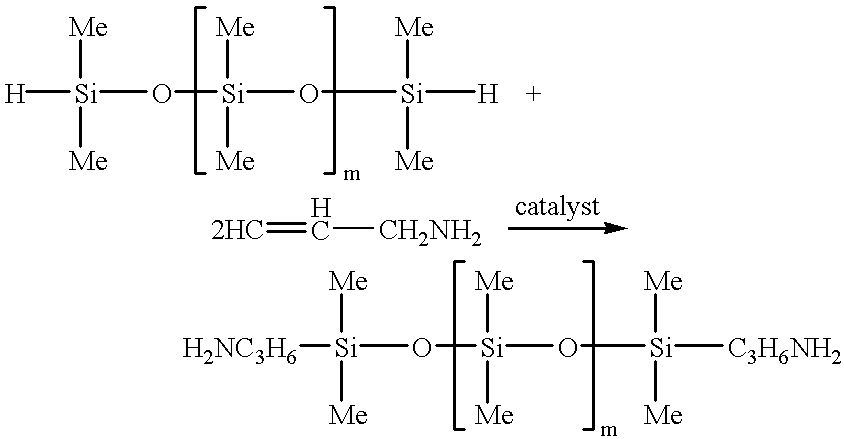Method for the preparation of aminopropyl or aminoalkyl functional polyalkyl or aryl siloxanes
a aminopropyl technology, applied in the field of aminopropyl or aminoalkyl functional polyalkyl or aryl siloxanes, can solve the problems of high boiling of residual endcappers, difficult to obtain endcappers, and difficult to remove polymers, etc., to achieve easy and convenient removal, simple reduction of pressure distillation, and cheap and convenient commercial products
- Summary
- Abstract
- Description
- Claims
- Application Information
AI Technical Summary
Benefits of technology
Problems solved by technology
Method used
Image
Examples
example 2
The procedure of example 1 was repeated using 7 parts of allylamine and 1000 parts of polydimethylsiloxane, hydride terminated. The polydimethylsiloxane, hydride terminated, had a viscosity of 763.81 centistokes, and a hydride content of 0.106 meq / g. After the reaction, the product had a viscosity of 829.6 centistokes, an amine content of 0.0991 meq / g, and a negligible amount of hydride.
example 3
The procedure of example 1 was repeated using 87 parts of allylamine and 2700 parts of polydimethylsiloxane, hydride terminated. The polydimethylsiloxane, hydride terminated, had a viscosity of 41.73 centistokes and a hydride content of 0.567 meq / g. After the reaction the product had a viscosity of 49.22 centistokes, an amine content of 0.522 meq / g, and no hydride content.
example 4
The procedure of example 1 was repeated using 48 parts of allylamine and 1000 parts of polydimethylsiloxane, hydride terminated. The polydimethylsiloxane, hydride terminated, had a viscosity of 2.43 centistokes and a hydride content 3.24 meq / g. After the reaction the product had a viscosity of 8 centistokes, an amine content of 3.02 meq / g, and no hydride content.
PUM
| Property | Measurement | Unit |
|---|---|---|
| temperature | aaaaa | aaaaa |
| temperature | aaaaa | aaaaa |
| temperature | aaaaa | aaaaa |
Abstract
Description
Claims
Application Information
 Login to View More
Login to View More - R&D
- Intellectual Property
- Life Sciences
- Materials
- Tech Scout
- Unparalleled Data Quality
- Higher Quality Content
- 60% Fewer Hallucinations
Browse by: Latest US Patents, China's latest patents, Technical Efficacy Thesaurus, Application Domain, Technology Topic, Popular Technical Reports.
© 2025 PatSnap. All rights reserved.Legal|Privacy policy|Modern Slavery Act Transparency Statement|Sitemap|About US| Contact US: help@patsnap.com



